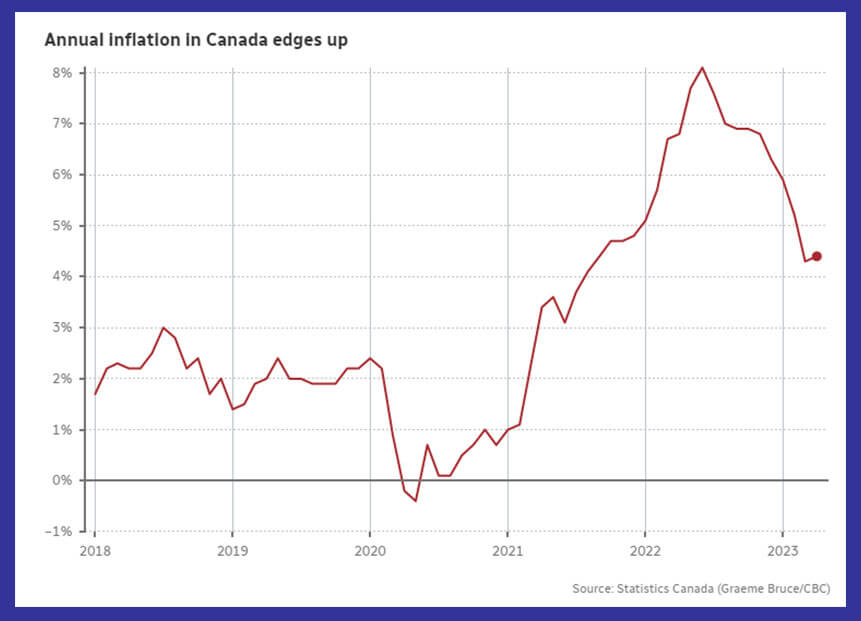Making sense of the markets this week: May 21, 2023

Presented By
Harvest ETFs
Inflation is back, solid quarters for Canadian insurance and energy companies, U.S. retail outperforms meagre expectations, and waiting for the X-date.
Advertisement

Presented By
Harvest ETFs
Inflation is back, solid quarters for Canadian insurance and energy companies, U.S. retail outperforms meagre expectations, and waiting for the X-date.

Kyle Prevost, editor of Million Dollar Journey and founder of the Canadian Financial Summit, shares financial headlines and offers context for Canadian investors.
The disinflationary good-news momentum finally came to an end on Tuesday, when Statistics Canada announced that the annualized inflation rate for April hit 4.4%.
Not only is that slightly higher than March’s 4.3% inflation figure, but it’s substantially more than the 4.1% predicted by most economists.

Of course, the major concern for market watchers is that if this re-inflation trend picks up this summer (when do gas prices not go up this time of year?), it could renew pressure on the Bank of Canada (BoC) to raise interest rates again in order to cool down demand. Naturally, that would be bad news for both bondholders and shareholders. The S&P/TSX Composite Index was down 1.2%—its worst daily result in three weeks—after the data was released.
While 4.4% is a far cry from a high of 8.1% last June, it’s still not music to the ears of consumers. The main culprits behind the higher-than-targeted inflation rate include:
Clothing, transportation, gas and household furnishings were all below 3% inflation.
The CPI news came on the heels of Monday’s announcement by the Canadian Real Estate Association (CREA) that the average home sale price in April was $716,000. That’s an increase of more than $100,000 since the start of the year. In fact, it appears that prices are rising so quickly that even the First-Time Home Buyer Incentive announced back in 2019 hasn’t really moved the needle, according to numbers from the Canada Mortgage and Housing Corporation. Despite the substantially lower-than-expected uptake, the government has stated the program will continue through May 2025.
Wal-Mart and Target had solid quarters that saw both companies continue to focus on selling necessities and reducing overall inventory. Home Depot on the other hand forecasted stormy skies ahead as it missed revenue projections. (All figures in this section are U.S. currency.)
When it comes to brick-and-mortar retailers, there is still Wal-Mart—and there’s everyone else.
The mass retailer company reported a solid earnings beat on the back of increased grocery and essential item sales. This new revenue was more than enough to offset the lowered sales of electronics and other discretionary items. Investors are still not in the mood to see the bright side these days, and only rewarded the share price with a 1% raise despite the significant earnings beat.
Target had a similarly upbeat earnings report, as it noted a 25% reduction in discretionary merchandise inventory. Target shares were up 3% on Wednesday.
On the other hand, Home Depot was down 2% on Tuesday, having missed revenue expectations. The big orange retailer reported that customers were buying fewer big-ticket items, like patio sets and grills. Overall, Home Depot’s revenues are still up $47 billion per year from 2020, due to the COVID-inspired renovation boom.
In a trend worth keeping an eye on, both Home Depot and Target reported a large increase in retail theft over the last year. One has to wonder if quickly increasing prices are behind the increase in shoplifting.
While Canadian banks get a lot of attention from Canadian investors, our domestic insurance companies also have a strong presence on the Toronto Stock Exchange. Due to new accounting standards this year, revenue numbers were not yet available but quarterly earnings results were mostly in line with expectations. (All figures in Canadian currency in this section.)
Overall, the Canadian insurance stalwarts continue to generally meet expectations and reliably generate profits. No lasting downward or upward momentum was created this quarter, as analysts at the market at large appear satisfied that they have a solid reading on the companies.
To give an idea how the insurance companies as a whole have been doing, the CI U.S. & Canada Lifeco Covered Call ETF (FLI) is down 8.33% year to date (YTD), while the iShares Equal Weight Banc & Lifeco ETF (CEW) is up 4.89% YTD. CEW is an all-Canadian offering, whereas FLI is more geographically diversified, but solely focused on the insurance sector.
The Canadian insurance industry is facing some recent headwinds due to changes in the tax code around the rate of tax applied to dividends that insurers receive from their investments in other Canadian companies. Pre-2023, insurers could take your premiums, invest that money into Canadian companies, then receive dividends without paying additional tax on them. This lack of tax obligation should not be characterized as a loophole, and is instead broad consistently with the widespread accounting concept of corporate tax integration. As of this year, the Canadian government stated that those dividends will be treated as business income, and consequently will be taxable.
Intact Financial CFO Louis Marcotte was quoted as saying:
“It also would increase the tax imbalance for us but also all Canadian insurers when facing their foreign counterparts.”
Intact went on to state that the tax changes would result in an increase of two percentage points overall (or $2 million per quarter).
Canada’s largest energy stocks are still realizing the benefits of Saudi-supported oil and gas prices as solid profit numbers were announced this quarter. (All figures are in Canadian currency in this section.)
It’s notable that, even with the significant earnings beat, Suncor share prices are still down 6.76% YTD, and down more than 20% compared to a year ago. The largest and most diversified of the energy giants, CNQ, is up 5.68% YTD, but down 4.37% from a year ago. Finally, Cenovus is down 12.75% in 2023, anddown 18.49% over the last 12 months.
Dividend investors are quick to point out that share-price movements don’t take into consideration the large quarterly dividend paycheques they receive nor the special dividends that most Canadian energy companies announced throughout 2021 and 2022.
Obviously, any company that depends so much on the price of one or two commodities is going to have a somewhat volatile stock price. So far in 2023, the lowered forecast for global growth has weighed on the price of oil. And a Russian-driven natural gas crisis seems to have been averted for the time being. That said, I have to think that shareholders of large Canadian energy producers are pretty happy with the overall results of the past three years. For more, check out our Canadian energy stocks article at Million Dollar Journey.
There is no doubt that rumours and counter-rumours in regards to the U.S. Debt Ceiling Debacle have also been influencing markets lately. Next week, we’ll focus on just how worried you should be as we approach the X-date.
Kyle Prevost is a financial educator, author and speaker. When he’s not on a basketball court or in a boxing ring trying to recapture his youth, you can find him helping Canadians with their finances over at MillionDollarJourney.com and the Canadian Financial Summit.
It was independently produced by MoneySense and is presented with financial support from the partner.
Share this article Share on Facebook Share on Twitter Share on Linkedin Share on Reddit Share on Email